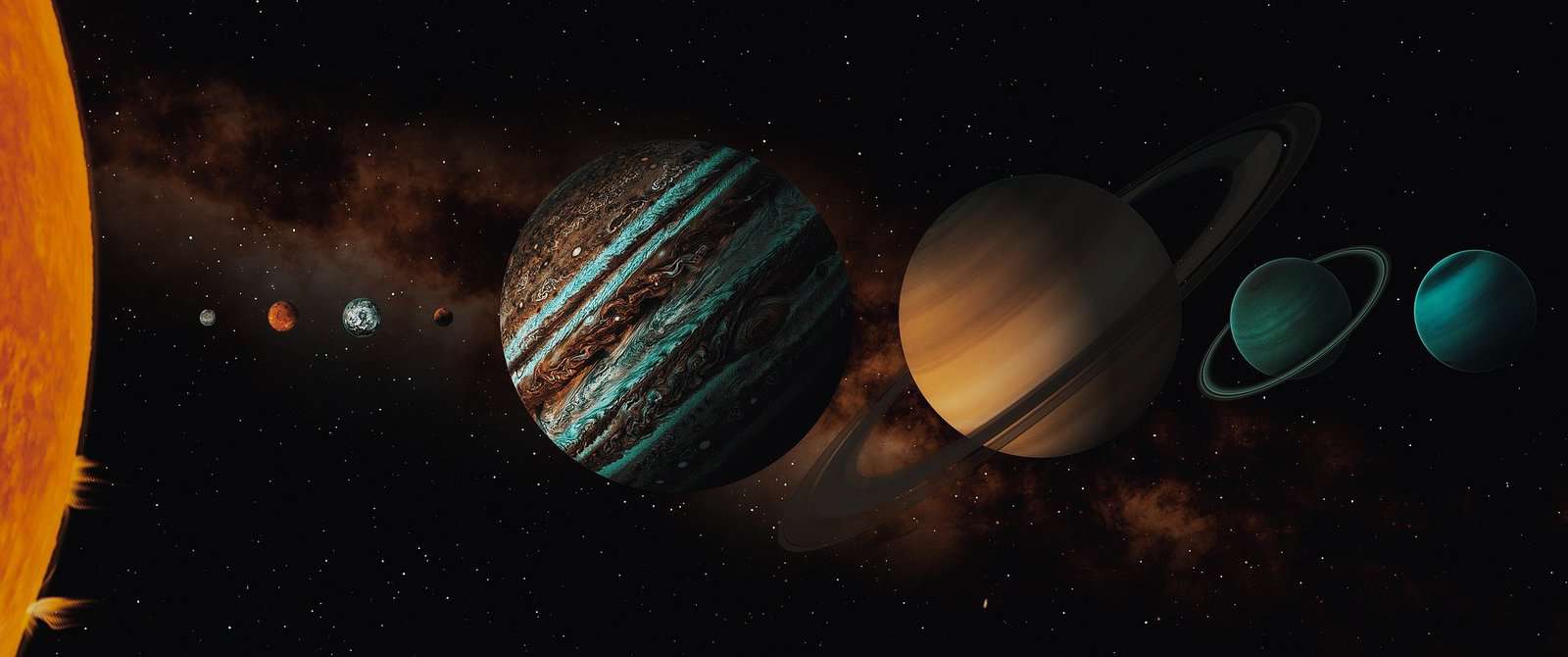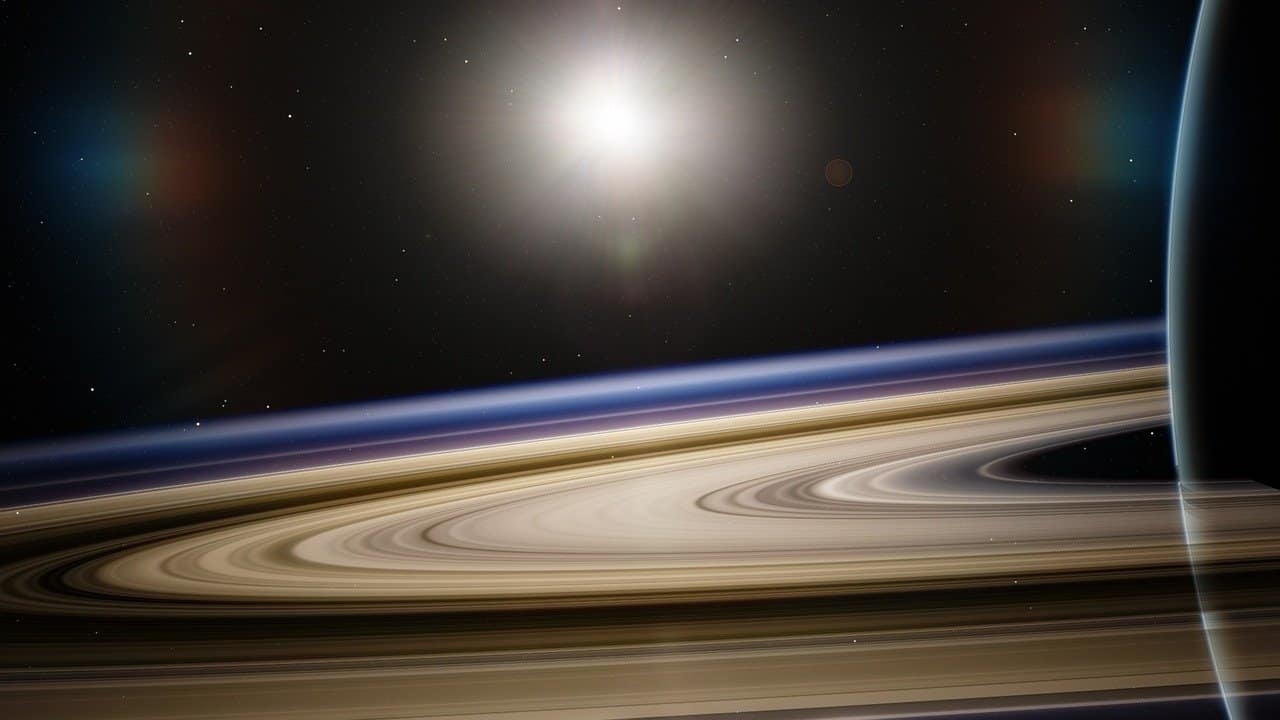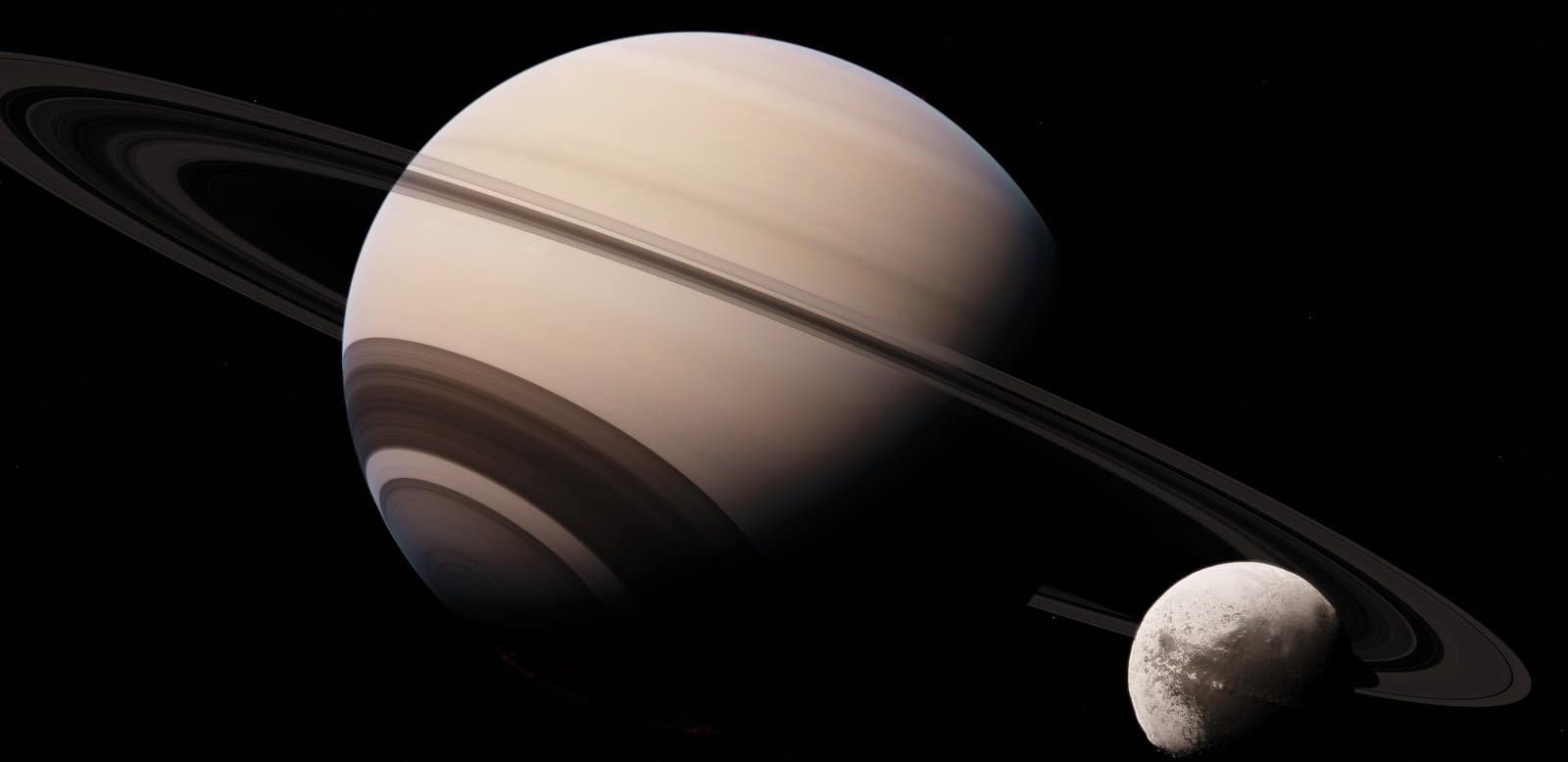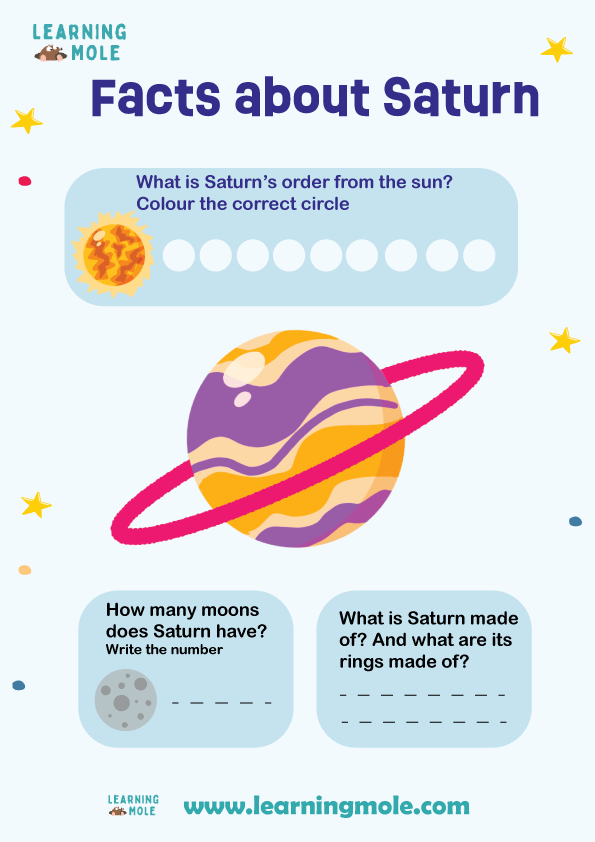
Explore Saturn: The Beautiful Ringed Planet
As humans, our fascination with the Solar System has been inspired by watching the stars and enjoying gazing at the vastness of the universe. One of the best-known planets in the Solar System is Saturn. It is famous for its beautiful rings.
Saturn is the sixth planet from the Sun, between Jupiter and Uranus, with an average distance of about 1.4 billion kilometres. It is an outer and a gas giant planet, along with Jupiter. In fact, Saturn and Jupiter have so much in common that they are considered as relatives. In addition, Saturn is the second largest planet in the solar system, after Jupiter. Let’s Explore this fascinating planet!

Structure and Surface
Saturn is one of the gas giant planets. This means that it consists of gases. The main two gases that make up Saturn are hydrogen and helium. At Saturn’s centre, there is a hot, rocky core of metals like iron. Although it is a huge planet, Saturn is very low in density because it is made up mostly of gases.
Because it is a gas giant, Saturn does not have a true surface. What looks like a surface is actually a layer of clouds. Under the huge layer of gases, there is a small area of hot liquid material. So, a spacecraft would have nowhere to land on Saturn. In addition, the extreme pressures and temperatures deep inside the planet would crush, melt, and vaporize any spacecraft trying to fly into the planet.
Atmosphere
Saturn has a huge atmosphere. It is made mostly of hydrogen, with some helium and smaller amounts of other gases. Scientists think that there may be small amounts of water vapour and hydrogen sulfide at lower levels of the atmosphere.
Saturn’s atmosphere is colored with white spots dotted around it. These signify the short-lived storms that appear after every full Saturn orbit. In addition, Saturn’s atmosphere has wind speeds as high as 1,800 kph which are thought to be some of the solar system’s fastest known wind speeds.
The winds on Saturn are worth discussion due to their incredible strength. The speed of the winds in Saturn’s upper atmosphere can reach 1,600 feet per second. If you compare it to the Earth’s strongest hurricane-force winds, they are a measly 360 feet per second. So, Saturn wins for its extremity. Not only that, but the pressure of the gases is also so powerful that, if it were possible for you to be within it, the pressure would make you feel like you were diving deep under the water. Saturn’s pressure is so intense that it squeezes anything gaseous into a liquid form.
In the upper atmosphere, there is a layer of haze that is created by reactions with ultraviolet light from the Sun. Saturn’s clouds are formed of molecules that condense in the atmosphere. The highest deck of clouds is made of crystals of frozen ammonia. Farther down, there are clouds made of frozen crystals of ammonium hydrosulfide. Deeper down, there are clouds of water ice crystals and small drops of ammonia. The clouds are rather beautiful and look like striped light jet streams and even storms with brown, grey, and yellow colours throughout them.

Temperature
The temperatures and pressures inside Saturn are very high, and the deeper inside it, the more they increase. The temperatures in the inner layers are much higher than the outside layers because of the heat that Saturn’s interior produces.
Saturn’s core is very hot; its temperature reaches 26,540 °F (14,727 °C). About halfway down between Saturn’s cloud tops and center, the temperature is probably about 10,300 °F (5,730 °C). The temperature in Saturn’s lowest cloud layer is quite low, at about -10°F (-23°C). The temperature at Saturn’s cloud tops is extremely low, at about -283°F (-175°C).
Size
Saturn is a huge planet. It is the second-largest planet in the Solar System. Its diameter is about 120,600 kilometres, which is nine times larger than Earth’s diameter. However, Saturn is very light for its size because it is made up of gases.
Jupiter, which is the biggest planet in the solar system, has 1.2 times the diameter of Saturn. Saturn’s diameter is more than 23 times the diameter of Mercury, which is the smallest planet in the Solar System.

Orbit and Rotation
Like all planets, Saturn has two types of motion: orbit around the Sun, and spin about its centre. Saturn completes an orbit around the Sun in about 29 Earth years. So, a year on Saturn is about 29 Earth years. In addition, Saturn’s axis is tilted with respect to its orbit around the Sun, which is similar to Earth’s tilted axis. This means that, like Earth, Saturn has seasons.
A day on Saturn is the second-shortest day of all planets in the solar system because Saturn spins very quickly about its centre. It takes the planet 10.7 hours to complete one rotation. So, a day on Saturn lasts only 10.7 hours.
Rings
There are very thin rings that surround Saturn. The rings are absolutely bright and beautiful, and they are easy to see with a telescope. They extend thousands of miles out from the planet. They are made up mostly of pieces of water ice, rock and dust. Their exact origin is unknown.
Scientists believe that the rings of Saturn are pieces of asteroids, comets, or shattered moons that broke up before they hit the planet. Then, the powerful gravity of Saturn tore those objects apart into smaller pieces. These objects range in size, from a centimetre to several metres, and some few are kilometre-sized.
There are seven rings named: A, B, C, D, E, F, and G rings. Scientists named them in the order they were discovered, which is different to their order from the planet. From the planet, they are: D, C, B, A, F, G and E. The main rings around Saturn are: A, B, and C. The fainter rings of D, E, F, and G are more recently discovered.
The rings are only around 20 meters thick, and they expand out over 12,700 km from Saturn. Each one of the rings orbits Saturn at a different speed. The rings are close to each other, except for rings A and B. There is a gap between these two rings called the Cassini Division, and it is about 4,700 km.

Moons
Saturn has 53 confirmed moons with 29 additional moons which are still being studied, and they are awaiting to be confirmed. Each of Saturn’s moons is unique. Seven of Saturn’s moons are large enough to be a near perfect sphere because of their own gravity. These moons are: Titan, Rhea, Iapetus, Dione, Tethys, Enceladus and Mimas.
The largest moon is Titan, which is a bit bigger than planet Mercury. It is the second-largest moon in the Solar System after Jupiter’s moon Ganymede. Its diameter is about 5,150 kilometres. Titan is the only moon in the solar system that has a thick atmosphere and clouds surrounding it. The atmosphere is very thick and rich in nitrogen. In addition, Titan is the only place in the solar system, other than Earth, that has lakes and much liquid on its surface. However, the liquid is methane, not water. It takes Titan 15 days and 22 hours to orbit Saturn once.
Hyperion and Phoebe are the next largest moons. Hyperion is irregular in shape, and it appears like a sponge. It is the second largest irregular moon in the solar system. Its diameter is more than 200 kilometres. It consists mostly of water ice and a small amount of rock. Hyperion spins, or rotates, in a chaotic way, which means that its axis of rotation wobbles.
Phoebe is half made out of rock, and half made out of ice. It is slightly irregular and not perfectly round. There are many craters on Phoebe caused by asteroids and other things crashing into it. It does not have any air, and there is no water on its surface. The diameter of Phoebe is 213 kilometres, making it about 15 times smaller than Earth’s Moon. Finally, Phoebe completes an orbit around Saturn in about eighteen months.

Name
Saturn is named after the Roman god of agriculture. In Greek mythology, he was known as Cronus, the father of Zeus (Jupiter). Because Saturn and Jupiter share so much in common, they have been listed as “relatives.” So, Saturn was given the name of the Roman father of the god Jupiter.
Why not try our Saturn Activity:
Discovery and Exploration
Saturn has been known since ancient times because it can be seen from Earth without telescopes. Until now, only four spacecraft have visited Saturn:
- NASA’s Pioneer 11 in 1979
- NASA’s twin Voyager 1 and 2 in 1980 and 1981, each provided wonderful details about Saturn.
- The international Cassini spacecraft in 2004, which kept orbiting Saturn and studying it for about 13 years. Scientists at NASA had planned that the craft would plunge into Saturn’s atmosphere and vaporize there after it completes its mission. The Cassini mission ended in September 2017. However, for a short time, it was able to collect some information about Saturn’s atmosphere before it broke apart. In addition, Cassini had dropped a spacecraft called Huygens onto Titan. Huygens was the first spacecraft to land on a moon other than Earth’s moon.
15 Interesting Facts about Saturn
- Saturn is nicknamed the “Ringed Planet”. It is not the only planet with rings, but Saturn’s rings are the only ones that are visible from Earth even with a small telescope.
- Saturn’s rings are as wide as 4.5 planets the size of Earth put side by side.
- Scientists believe that Saturn will lose its rings, but this may happen in about 100 million years.
- Light from Saturn takes about 1 hour and 29 minutes to reach us on Earth and be visible.
- Saturn is the least dense planet among all the planets in the solar system. It is lighter than water, and if you could put it on water, it would float.
- Saturn is the flattest planet in the Solar System. Its equatorial diameter is greater than the planet’s polar diameter. So, if you look at Saturn through a telescope, it will appear flattened, not spherical.
- Saturn is so hot that it gives out more heat energy than it receives from the Sun.
- Saturn appears in a pale yellow colour because its upper atmosphere contains a high amount of ammonia crystals.
- There are periodic storms on Saturn, and they are large enough to be seen from Earth. They are called “White Spots”.
- The winds on Saturn are the second fastest among the solar system’s planets after the winds on Neptune.
- The Romans named the seventh day of the week Saturday for the planet Saturn.
- Saturn is so big that 764 Earths could fit inside it.
- Almost 1600 Saturns could fit into the Sun.
- Combining Jupiter and Saturn together makes up 92% of the entire mass of the Solar System – a huge amount!
Why not subscribe to our LearningMole Library for as little as £1.99 per month to access over 1000 fun educational videos.



Leave a Reply